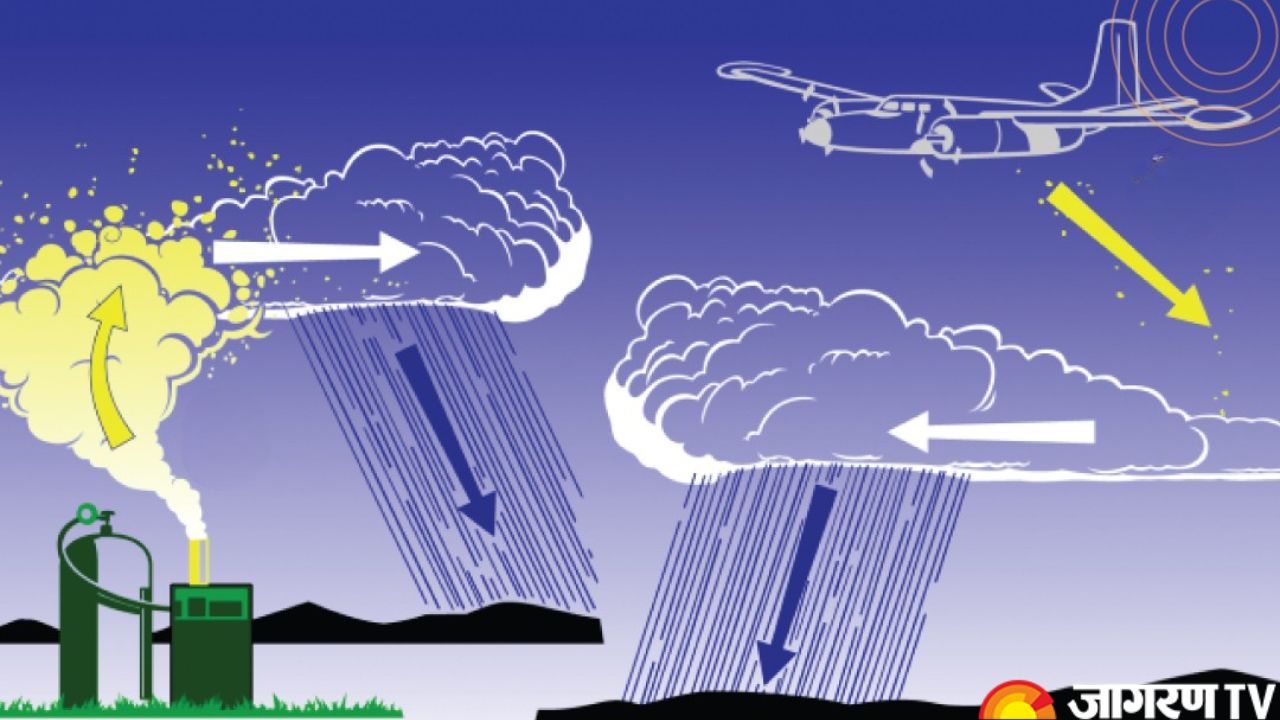Artificial Rain in Delhi: What is Cloud Seeding? Know How Does it Work, Common Agents and Implementation

Artificial Rain in Delhi: The national capital is going to witness its first artificial rain this monsoon season, as part of the Indian Government’s initiative to combat pollution. The project, titled “Technology Demonstration and Evaluation of Cloud Seeding as an Alternative for Delhi NCR Pollution Mitigation,” and led by the Delhi Environment Department in collaboration with IIT Kanpur, was originally scheduled to take place between July 4 and July 11, 2025, but due to unpleasant weather conditions, it has been rescheduled for August 2025, according to Delhi Chief Minister Rekha Gupta and Environment Minister Manjinder Singh Sirsa.
This approach, also known as Cloud Seeding, tries to coax additional precipitation out of current clouds, potentially saving drought-stricken areas and providing a tool for addressing a variety of environmental concerns. Ahead of this initiative, let’s take a look at the cloud seeding procedure, how it works, and more about artificial rain.
What is Cloud Seeding?
Artificial rain is a meteorological procedure that enhances the natural precipitation of existing clouds. Essentially, it is a human intervention that encourages clouds to precipitate or increases the amount of rain they produce. The technology promises to provide a tailored solution for drought-affected regions, or, in the case of Delhi, to potentially remove pollutants from the environment.
How Cloud Seeding Happens?
Cloud seeding works by adding tiny particles, known as “seeding agents,” into clouds with the necessary properties, specifically clouds containing supercooled water droplets (water that is still liquid below 0°C).
Identification
Meteorologists first identify clouds that have the potential to deliver rain but need a “nudge.” These are usually clouds with a high moisture content and appropriate temperatures.
Delivery of Seeding Agents
Seeding chemicals can be delivered into these clouds using a variety of methods:
-
Aircraft: Aeroplanes with flares or generators inject the substances directly into cloud formations. This is frequently the most successful approach for targeting certain cloud types and heights.
-
Ground-based Generators: These generators expel seeding agents from the ground, which subsequently ascend into the clouds via updrafts. This approach is typically less exact, but it can cover bigger regions.
-
Rockets/Artillery: Rockets or artillery shells can also be employed to carry seeding substances into clouds, however, this is less usual in routine operations.
Facilitating Condensation and Freezing
Once dispersed, the seeding agents function as artificial “ice nuclei” or “condensation nuclei.”
-
Ice Nuclei (for cold clouds): In cold clouds (when temperatures are below freezing), substances such as silver iodide offer a structure for supercooled water droplets to freeze and form ice crystals. These ice crystals then expand rapidly by absorbing more supercooled water.
-
Condensation Nuclei (for warm clouds): In warmer clouds, hygroscopic (water-attracting) elements such as salt can be utilised. These particles collect water vapour, resulting in bigger droplets that are more likely to collide and combine, eventually becoming heavy enough to rain.
Precipitation
As the ice crystals or water droplets grow in size and weight, they become too heavy to stay suspended in the cloud and fall to the ground as rain, snow, or hail, depending on the meteorological circumstances.
Common Agents for Cloud Seeding
Silver Iodide (AgI)
This is the most popular and effective agent for cold cloud seeding. Its crystalline structure is strikingly comparable to that of ice, making it an ideal ice nucleus.
Dry Ice (Solid Carbon Dioxide - CO2)
When mixed with supercooled clouds, dry ice rapidly cools the surrounding air, causing supercooled water droplets to freeze instantly and spontaneously. It is commonly used from aircraft.
Hygroscopic Salts
Salts such as sodium chloride (common table salt) and calcium chloride are used to seed warm clouds. They rapidly absorb water vapour, which encourages the development of bigger water droplets.
Liquid Propane
Similar to dry ice, liquid propane can be discharged from ground-based dispensers to quickly chill air and cause freezing in supercooled clouds.
Use of Artificial Rain
The possible applications of artificial rain are numerous and show great promise for tackling crucial environmental and economic issues.
Drought Mitigation
This is probably the most obvious and commonly referenced use. Cloud seeding can help in reducing drought by increasing precipitation in water-stressed areas, restocking reservoirs, and promoting agriculture.
Water Resource Management
Artificial rain can help to improve water resource management by inducing rainfall strategically and providing an adequate supply for drinking, irrigation, and industrial use.
Suppressing Hailstorms
Cloud seeding is done in some agricultural areas to protect crops from hailstones. By stimulating the formation of more numerous, smaller ice particles, it can diminish the size of individual hailstones, reducing their destructive power.
Fog Dispersal
Cloud seeding techniques, particularly those that involve hygroscopic materials, can be used to disperse fog at airports, increasing visibility and minimising flight delays.
Air Pollution Control
Artificial rain presents an appealing, if difficult, potential solution to severe air pollution in cities such as Delhi. By causing rain, particulate matter and other pollutants suspended in the atmosphere can be “washed out,” resulting in a temporary improvement in air quality. This is especially appealing during times of heavy pollution when natural rain is uncommon.
Forest Fire Control
In locations prone to wildfires, producing rainfall may help in controlling or containing blazes, albeit this is a more difficult application.
Related Videos
यह भी पढ़ें
-
09 Apr, 2023
IPL 2023 : आज हैदराबाद और पंजाब में कौन मारेगा बाजी, ऐसी हो सकती है दोनों टीम की प्लेइंग इलेवन
-
09 Apr, 2023
कोरियन दूल्हे ने इंडियन स्टाइल में की शादी, घोड़ी भी चढ़ा और भांगड़ा भी किया, वीडियो हुआ वायरल
-
09 Apr, 2023
-
09 Apr, 2023
आकांक्षा दुबे मामले में आरोपी समर सिंह को भीड़ ने दौड़ाया, 14 दिन की न्यायिक हिरासत








